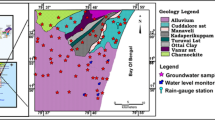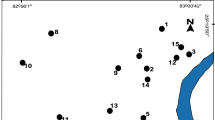Abstract
Present study is an effort to distinguish between the contributions of natural weathering and anthropogenic inputs towards high salinity and nutrient concentrations in the groundwater of National Capital Territory (NCT) Delhi, India. Apart from the source identification, the aquifer of entire territory has been characterized and mapped on the basis of salinity in space and water suitability with its depth. Major element chemistry, conventional graphical plots and specific ionic ratio of Na+/Cl−, SO4 2−/Cl−, Mg2+/Ca2+ and Ca2+/(HCO3 −+SO4 2−) are conjointly used to distinguish different salinization sources. Results suggest that leaching from the various unlined landfill sites and drains is the prime cause of NO3 − contamination while study area is highly affected with inland salinity which is geogenic in origin. The seasonal water level fluctuation and rising water level increases nutrients concentration in groundwater. Mixing with old saline sub-surface groundwater and dissolution of surface salts in the salt affected soil areas were identified as the principle processes controlling groundwater salinity through comparison of ionic ratio. Only minor increase of salinity is the result of evaporation effect and pollution inflows. The entire territory has characterized into four groups as fresh, freshening, near freshening and saline with respect to salinity in groundwater. The salinity mapping suggests that in general, for drinking needs, groundwater in the fresh, freshening and near freshening zone is suitable up to a depth of 45, 20 and 12m, respectively, while the saline zones are unsuitable for any domestic use. In the consideration of increasing demand of drinking water in the area; present study is vital and recommends further isotopic investigations and highlights the need of immediate management action for landfill sites and unlined drains.








Similar content being viewed by others
References
APHA (1995) Standard methods for the examinations of water and waste water, 17th edn. Washington DC, USA
Aryal RK, Murakami M, Furumai H, Nakajima F, Jinadasa HKPK (2006) Prolonged deposition of heavy metals in infiltration facilities and its possible threat to groundwater contamination. Water Sci Technol 54(6–7):205–212
Banner JL, Wasserburg GJ, Dobson PF, Carpenter AB, Moore CH (1989) Isotopic and trace element constraints on the origin and evolution of saline groundwaters from centural Missouri. Geochim Cosmochim Acta 53:383–398
CGWB (Central Ground Water Board) (2003) Groundwater in Delhi-improving the sustainability through rain water harvesting. Central Ground Water Board, Delhi
Chadha DK (1999) A proposed new diagram for geochemical classification of natural waters and interpretation of chemical data. Hydrogeol J 7:431–439
Craig E, Anderson MP (1979) The effects of urbanization of ground water quality. A case study of ground water ecosystems. Environ Conserv 30(2):104–130
Das Brijraj IL, Kakar YP, Moser H, Stichler W (1988) Deuterium and oxygen-18 studies in groundwater of the Delhi area. India J Hydrol 98:133–146
Datta PS, Tyagi SK (1996) Major ion chemistry of groundwater in Delhi area:Chemical weathering processes and groundwater flow regime. J Geol Soc India 47:179–188
Datta PS, Bhattacharya SK, Tyagi SK (1996) 18O studies on recharge of phreatic aquifers and groundwater flow-paths of mixing in the Delhi area. J Hydrol 176:25–36
DeSimone LA, Howes BL, Barlow PM (1997) Mass-balance analysis of reactive transport and cation exchange in a plume of wastewater-contaminated groundwater. J Hydrol 203:228–249
Ghabayen SMS, McKee M, Kemblowski M (2006) identification of salinity sources and missing data in the Gaza aquifer. J Hydrol 318(2006):360–373
Glen EP, Cohen MJ, Morrison JI, Valdes-Casillas C, Fitzsimmons K (1999) Science and policy dilemmas in the management of agricultural waste waters: the case of the Salton Sea, Ca, USA. Environ Sci Policy 2:413–423
Handa BK (1988) Content of potassium in groundwater in India. Fertilizer News 33(11):15–27
Hern J, Feltz HR (1998) Effects of irrigation on the environment of selected areas of the Western United States and implications to world population growth and food production. J Environ Manag 52:353–360
Klimas A, Paukstys B (1993) Nitrate contamination of groundwater in the Republic of Lithuania. NGU Bull 424:75–85
Kumar M (2004) An integrated hydrogeochemical and isotopic study of NCR-Delhi, India. Mphil, Jawaharlal Nehru University, India [in English]
Kumar M, Ramanathan AL, Rao MS, Kumar B (2006) Identification and evaluation of hydrogeochemical processes in the groundwater environment of Delhi. India Environ geology, Springer Pub 50:1025–1039
Kumar M, Kumari K, Ramanathan AL, Saxena R (2007) A comparative evaluation of groundwater suitability for irrigation and drinking purposes in two agriculture dominated districts of Punjab, India. Environ Geology, Springer Pub http://dx.doi.org/10.1007/s00254-007-0672-3
Matthess G (1982) The properties of groundwater. Wiley, New York, p 498
Metcalf & Eddy Inc. (2000) Integrated Aquifer Management Plan: Final Report. Gaza Coastal Aquifer Management Program, USAID Contract No. 294-C-00-99-00038-00
Miller GT (1979) Living in the environment, Belmonol California, Wordsworth Publishing company, CA, p470
O’Riordan T, Bentham G (1993) The politics of nitrate in the Ž.UK. In: Burt TP, Heathwaite AL, Trudgill ST (eds) Nitrate—Processes, patterns and management. Wiley, New York, pp 403–416
Paliwal KV, Yadav BL (1976) Irrigation water quality and crop management in U.T. of Delhi. Water Technol. Centre, IARI, New Delhi. Res Bull 9:1–45
Rajmohan N, Elango L (2005) Nutrient chemistry of groundwater in an intensively irrigated region of Southern India. Environ Geol 47:820–830
Ramesam V (1982) Geochemistry of groundwater from a typical hard rock terrain. J Geol Soc India 23:201–204
Rao NS (1998) Impact of clayey soils on nitrate pollution in the groundwater of the lower Vamsadhara river basin, India. Hydrol Sci J 43:701–714
Ronen D, Kanfi Y, Magaritz M (1983) Sources of nitrates in groundwater of the Coastal Plain of Israel—evolution of ideas. Water Res 17:1499–1503
Scheytt T (1997) Seasonal variations in groundwater chemistry near Lake Belau, Schleswig-holstein, Northern Germany. Hydrogeol J 5:86–95
Seth NN, Khanna SP (1969) A note on groundwater conditions in the Delhi area. Geol Surv India Misc. Publ. No. 14, Part III, pp 101–110
Sharma B, Kumar M, Ramanathan AL (2004) Impact of Surface Water on the Groundwater Quality in and around Najafgarh Drain, Delhi. In: Ramesh R, Ramachandran S (eds) Freshwater management. Capital publishing Company, Delhi, pp 70–86
Shuval H, Gruener N (1977) Infant methemoglobinemia and other health effects of nitrates in drinking water. Prog Water Technol 8(4/5):183–193
Singh UK, Kumar M, Chauhan R, Jha PK, Ramanathan AL, Subramanian V (2007) Assessment of the impact of landfill on groundwater quality: a case study of the Pirana site in western India. Environmental Monitoring and Assessment. doi:10.1007/s10661-007-9897-6
Vengosh A, Ben-Zvi A (1994) Formation of a salt plume in the coastal plain aquifer of Israel: the Be’er Toviyya region. J Hydrol 160:21–52
Vengosh A, Rosenthal E (1994) Saline groundwater in Israel: its bearing on the water crisis in the country. J Hydrol 156:389–430
Vengosh A, Heumann KG, Juraski S, Kasher R (1994) Boron isotope application for tracing sources of contamination in groundwater. Environ Sci Technol 28(11):1968–1974
Vengosh A, Spivack AJ, Artzi Y, Ayalon A (1999) Geochemical and Boron, Strontium, and Oxygen isotopic constraints on the origin of the salinity in groundwater from the Mediterranean coast of Israel. Water Resour Res 35(6):1877–1894
Vengosh A, Gill J, Davisson ML, Hudson GB (2002) A multiisotope (B, Sr, O, H, and C) and age dating study of groundwater from Salinas Valley, California: hydrochemistry, dynamics, and contamination process. Water Resour Res 38(1):1–17
WHO (2004) Guidelines for drinking water quality-II pp 333. Geneva, Environmental Health Criteria, 5
Acknowledgments
Our sincere thanks are due for the anonymous reviewer and editor for their thought provoking comments, which lead to spectacular refinement of the manuscript quality. Author (MK) thanks Council of Scientific and Industrial Research (India) for financial grant through research fellowship. The authors also acknowledge the Department of Science and Technology (DST), University Grant Commission (UGC) and Ministry of Water Resources (MOWR) under Govt. of India for their financial support. We would also like to thank Rita Chauhan and Gurmeet Singh for their able support in map and manuscript preparation.
Author information
Authors and Affiliations
Corresponding author
Rights and permissions
About this article
Cite this article
Kumar, M., Sharma, B., Ramanathan, A. et al. Nutrient chemistry and salinity mapping of the Delhi aquifer, India: source identification perspective. Environ Geol 56, 1171–1181 (2009). https://doi.org/10.1007/s00254-008-1217-0
Received:
Accepted:
Published:
Issue Date:
DOI: https://doi.org/10.1007/s00254-008-1217-0




